
Winter is a great time to take inventory, clean up, protect plants and plan activities for the upcoming season. Remember, there are still many things to do. Do you enjoy growing a home garden? Check out what you can do during the winter months!
During December, you can organize your tools. Sharpen your pruning shears, fix loose handles and wash your gardening gloves. Sharpened, clean equipment is safer and better for plants because it reduces the risk of disease transmission. If you have a greenhouse or shed, now is the perfect time to clean it out
What can you do in the garden in the winter? Prepare a gardening calendar for next year. Don’t be discouraged by imperfections or setbacks. Think about what you can improve on next season. This is a good time to deepen your gardening knowledge
You can store carrots, parsnips, cabbage, potatoes, late varieties of apples, pears, squash, beans, onions, garlic, shallots and root vegetables in your basement over the winter. Carefully inspect your harvest and throw out anything that is not in perfect condition. Not only will it rot, but it will contaminate your other crops.
Yourgarden gets dark faster inthe winter . Add some brightness to your garden by hanging some stylish lanterns. It’s a simple, inexpensive and quick way to decorate your surroundings
It’s too early to dig, but you can order seeds for the vegetables and fruits you plan to grow in the spring. Look through gardener’s catalogs. You’ll find more interesting varieties than you can at the big garden centers.
Fruit trees are dormant now, so you can take it easy pruning them. Remove dead, diseased and damaged wood. Trim weaker branches. Remember to wear gloves beforehand. Use sharp, clean tools and cut branches at an angle.
Most garden wildlife hibernates at this time of year because food is scarce and cold temperatures make life difficult. They hide in piles of leaves and twigs, nest in tree bark or bury themselves in compost or mud. Some animal species, such as birds and squirrels, don’t hibernate but struggle to survive. Fortunately, there are several ways to help them
Put up bird feedersin your garden during the winter. They need caloric bacon, sunflower seeds and peanuts to keep their fat reserves up on cold nights. On colder days, look out for mistletoes, gilas, sparrows and tits. Leave food out for them every day. You can supplement it with nuts, sunflower seeds and fallen fruit.
Many insects may be hibernating in your garden. Bumblebees dig holes in the ground or rest in mulch, butterflies sleep in garages and sheds. Wasps and ladybugs, on the other hand, hide under loose tree bark and in cracks in doors and windows. If you disturb them, they are likely to die. If for some reason you can’t leave them alone, move them to a cool place where they will settle down again.
Almost half of all hedgehogs die during their first winter in the garden. Many individuals die of starvation, while hedgehogs born in late summer are often too small to hibernate. Provide shelter for them by making a pile of leaves or building a house. Leave a bowl of water and dog or cat food. If you find a baby hedgehog, keep it warm in a tall box with a thermophore on the bottom, covered with a thick towel. Feed it food and water and contact your vet.
Tidy up overwintering geraniums, try growing citrus fruits or plant succulents in a pot. If temperatures are dropping, you can place containers of water in the greenhouse. For smaller greenhouses, place covered one-liter plastic jugs filled with water between the plants. Paint them black or add black food coloring to the water to increase heat absorption
If you want to use the greenhouse duringthe winter, try a germination heating mat. It helps keep the root zone at the right temperature and increases the growth rate in the early stages of the plant’s vegetative cycle. In addition, insulate your greenhouse by attaching bubble wrap to the inside walls. This will reduce heat loss and block winter drafts.